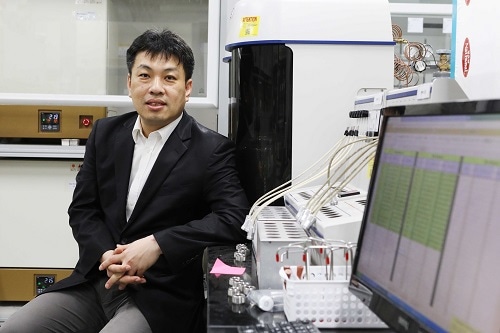May 2 2019
Researchers at KAIST doped nitrogen and boron into graphene to selectively raise peroxidase-like activity and were successful in synthesizing a peroxidase-mimicking nanozyme with a cost-effective and excellent catalytic activity. These nanomaterials can be used for early diagnosis of Alzheimer’s disease.
 Professor Jinwoo Lee from the Department of Chemical and Biomolecular Engineering. (Image credit: KAIST)
Professor Jinwoo Lee from the Department of Chemical and Biomolecular Engineering. (Image credit: KAIST)
Enzymes are the key catalysts in a person’s body and are extensively used in bioassays. Particularly, peroxidase, which oxidizes transparent colorimetric substrates to become a colored product when exposed to hydrogen peroxide, is the most typical enzyme that is used in colorimetric bioassays.
But, natural enzymes made up of proteins are unsteady against temperature and pH, tough to synthesize, and costly. Nanozymes, conversely, do not have proteins, meaning the drawbacks of enzymes can be overcome with their strength and high productivity. In contrast, a majority of nanonzymes do not possess selectivity; for instance, peroxidase-mimicking nanozymes display oxidase-like activity that oxidizes colorimetric substrates in the absence of hydrogen peroxide, which prevents them from exactly sensing the target materials, such as hydrogen peroxide.
Professor Jinwoo Lee from the Department of Chemical and Biomolecular Engineering and his team managed to synthesize a peroxidase-mimicking nanozyme with excellent catalytic activity and selectivity toward hydrogen peroxide. Co-doping of boron and nitrogen into graphene, which has marginal peroxidase-like activity, selectively raised the peroxidase-like activity without oxidase-like activity to exactly imitate the nature peroxidase and has become a strong option to substitute the peroxidase.
The experimental outcomes were also confirmed using computational chemistry. The nitrogen and boron co-doped graphene was also applied to the colorimetric detection of acetylcholine, which is a vital neurotransmitter and positively detected the acetylcholine even better than the nature peroxidase.
We began to study nanozymes due to their potential for replacing existing enzymes. Through this study, we have secured core technologies to synthesize nanozymes that have high enzyme activity along with selectivity. We believe that they can be applied to effectively detect acetylcholine for quickly diagnosing Alzheimer’s disease.
Jinwoo Lee, Professor, Department of Chemical and Biomolecular Engineering, KAIST.
This study, led by PhD Min Su Kim, was published in ACS Nano (10.1021/acsnano.8b09519) on March 25th, 2019.